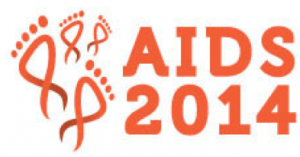Higher ART coverage is associated with lower HIV infection rates in a multi-country analysis
1 August 2014. Related: Conference reports, Treatment strategies, HIV prevention and transmission, World AIDS 20 Melbourne 2014.
 Polly Clayden, HIV i-Base
Polly Clayden, HIV i-Base
If all low- and middle-income countries had achieved the same level of antiretroviral treatment (ART) coverage as Botswana in 2012, 65% of new HIV infections and 70% of HIV-related deaths could have been prevented – according to an analysis presented at AIDS 2014. [1]
A multi-country survey by Andrew Hill and colleagues from the University of Liverpool, St Stephens Centre, London, Imperial College, London and World Health Organisation – presented as a late breaker poster – looked at the relationship between the percentage of HIV positive people on ART to HIV incidence and related deaths. The analysis also compared ART coverage rates between low-, middle- and high-income countries.
The researchers used 2012 UNAIDS country-level estimates for 51 low- and middle-income countries: 36 from African and 15 non-African with at least 50,000 people with HIV. Data from published references were used for the seven high-income countries but these were not used in the calculations of the associations between coverage and incidence. Weighted least squares and linear regression models were used in the investigations.
The mean percentage of ART coverage across the low- and middle-income countries was 30% with a wide variation ranging from 0.6% in Madagascar to 62% in Botswana. The mean percentage of new HIV infections was 6.1% and this ranged from 2% in Thailand to 12.5% in Indonesia.
The researchers found a highly significant association between greater ART coverage and both lower percentage incidence and HIV-related deaths (p<0.00001 for both associations). Each 10% increase in ART coverage was associated with a 1.15% reduction in new infections and a 1.13% reduction in HIV-related deaths.
Further analyses suggested that the same level of coverage as Botswana (62%) across all low- and middle-income countries could have prevented 1,243,647 of the 1,901,800 (65%) new HIV infections in 2012. In the same period, under the same conditions, 998,732 out of 1,427,200 (70%) deaths from HIV could have been prevented.
The 51 countries in the analysis plus seven high income ones were ranked according to percentage of HIV positive people receiving ART. Levels of coverage across high-income countries also varied considerably from 67% in the UK to 33% in the US. The US ranked 30th out of 58 countries – between Burandi and Uganda.
The researchers wrote: “The results provide a compelling argument for continuing to improve antiretroviral treatment coverage worldwide.”
Comment
Andrew Hill also presented these data in a workshop on trial design for low-income countries. [2] He noted that in the UK the breakpoint in the cascade was between the estimated number of HIV positive people and diagnosis/link to care, respectively 98,400 and 77,610 (79%).
Dr Hill remarked that there are many other differences between countries, which might explain these associations. For example countries with better treatment coverage might also have better HIV prevention programmes.
He also pointed out variability around the association – some countries have high rates of new infections, despite high ART coverage, such as Uganda, or low infection rates despite lower ART coverage, as in Niger.
The analysis is being repeated using the new 2013 UNAIDS database, for validation. The researchers will look in detail at the methods used by UNAIDS to estimate their rates of new HIV infections and deaths, and refine their methods.
References:
- Hill A et al. Higher antiretroviral treatment coverage is associated with lower adult HIV infection rates: analysis of 51 low and middle-income countries. 20th International AIDS Conference. Melbourne. 20-25 July 2014. Late breaker poster abstract LBPE29.
http://pag.aids2014.org/abstracts.aspx?aid=11070 - Hill A. Is higher antiretroviral treatment coverage associated with lower HIV infection rates? 20th International AIDS Conference. Melbourne. 20-25 July, 2014. Workshop presentation TUWS1103.
http://pag.aids2014.org/abstracts.aspx?s=1967

